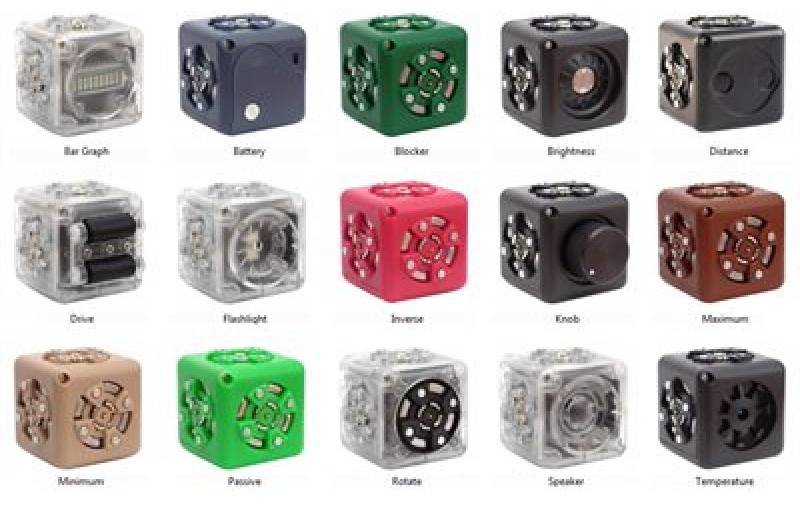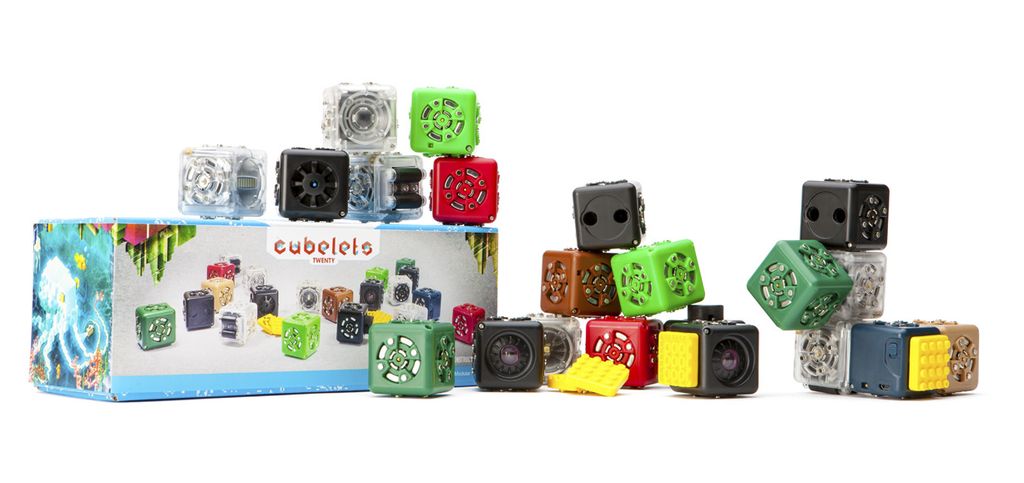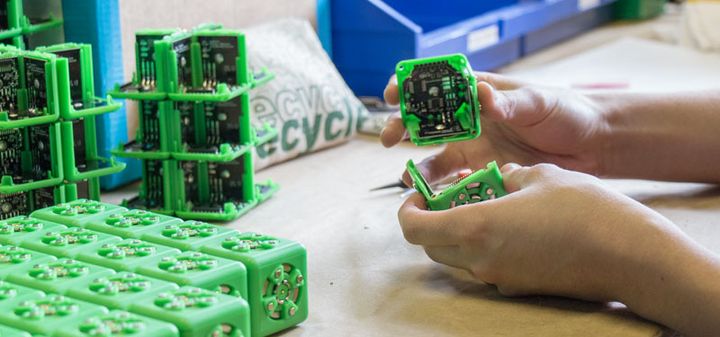
Considering the fact that we are close to an age where robots are likely to be a common feature in the home - as well as the workplace, factories, constructions sites, and just about everywhere else - educating our children on how to build and maintain them seems like a good idea. And while there are plenty of examples of tech toys that teach programming and assembly on the market, these tend to appeal to older crowds who are already technologically literate.
Luckily, Modular Robotics - a Boulder, Colorado-based consumer electronics company - and others like it have spent the past few years creating child-friendly applications for robotics. Known as Cubelets, these modular robot kits consists of inch-sized cubes that are snapped together to create autonomous machines, helping children to learn the basics of robotics while at the same time developing their problem-solving skills.
Released by Eric Schweikardt and his team at Modular Robotics in 2011, the company has since teamed up the National Science Foundation's (NSF) Small Business Innovation Research (SBIR) program to make them commercially available. The product line now comes in 16 varieiies - ranging in functionality from distance measurement to Bluetooth compatibility - with each cube containing a series of magnets, electronics, and a small internal computer.

They are further broken down into three species of components - Action, Sense, and Think/Utility - each of which can be magnetically snapped together in any arrangement to create a semi-intelligent autonomous robot. As Schwelkardt explained: "That's our working definition of a robot - any mechanical device that senses, thinks and acts."
Action blocks consist of motors for moving your robot, speakers, flashlights, and rotation. Sense blocks have sensors that respond to distance, temperature, or brightness. And Thinker/Utility cubes provide programmatic functions, battery power, and “insulator” blocks that carry power, but prevent signals from propagating.
Taken together, these basic modules provide all of the necessary functions to build a working robot. And to children, it provides the basic framework for understanding how different components and sub-systems can come together to create something that is more than just the sum of its parts - which is another important aspect of computing and robotics.

"Cubelets are an example of a complex system." Schwelkardt added. "They're made of lots of little cubes - each with a different capability, such as a distance sensor cube, a drive motor cube with wheels and a battery cube. And, when you put them together, they do something greater, such as drive when they detect an object. They're inspired by natural systems of individuals that join forces and work together, such as insect swarms or birds flying in a 'V' formation."
This last feature of the Cubelets functionality is extremely important, as it indicates that they are part of a larger move towards swarm robotics and group behavior in machines - things which will likely become very important when it comes to programming tinier and tinier machines to perform increasingly complex behaviors. As such, it is little wonder why Modular Robotics was joined by the NSF in 2013 in order to bring their invention to market.
As a government agency created for the purpose of funding research and education, the NSF has a vested interest in ensuring that future generations are prepared for the challenges that will face them. And as NSF program manager Glenn Larsen explained, the robotic toys his organization helped to create will have long-ranging effects when it comes to teaching children about the world they will be inheriting.
"Cubelets, by Modular Robotics, make powerful ideas of computational thinking accessible in a fun and hands-on way to students of all ages," he said. "The next generation of citizens needs to understand complex systems like our ecosystem and our economy. Cubelets lays the foundation for this understanding by putting the building blocks of complex systems in children's hands."
In addition to Cubelets, Modular Robotics is also responsible for the creation of the MOSS line of toys, which includes the Zombonitron 1600 and the Exofabulatronixx 5200. Similar in theory to Cubelets, these two robotics systems involve building machines out of multiple magentic blocka. motors, sensors and carbon steel spheres to create machines that drive around, are equipped with lights, and perform all kinds of cool functions.
And, much like Cubelets, they are capable of doing this all autonomously, without the need of programming or wires. Of course, the MOSS line has attracted its fair share of attention since it's release last year. In addition to making USA Today's Top 10 tech toys list from Toy Fair 2014 - which showcases high-tech educational devices for kids - they were also given a Hot Stuff Award, as part of the 2014 Consumer Electronics Show.
And of course, Modular Robotics isn't the only company producing modular components kits to make learning fun. At about the same time that Cubelets were first making their debut in 2011, the tech company Sifteo unveiled its concept for an educational game platform that uses three to six cubes with screens on their faces to enable interactive gaming experiences.

Currently, Sifteo comes with 17 games, including Word Play - an anagram-type game in which a different letter appears in each square and users try to assemble words; Gofer Run, where gamers manuever a gopher through a maze by tilting blocks, but are limited in how much of the maze they can see based on how many blocks they have; and Matchination, a game where users match geometric shapes on cube edges to gain points and move to the next level.
In all cases, the screens on one side of the blocks act as buttons as well, and respond to tilts and changes in their position relative to other blocks. One minor drawback is the fact that these blocks are not "smart", in the sense that they contain enough computational memory or processing power to run all on their own. As it stands, the games are all run via computer. which must be in constant communication with the blocks via a USB dongle.
Another universal drawback comes in the form of pricing. Whereas Cubelets can cost as much as 159.95 for a six pack, and 495.95 for a pack of twenty, a starter set of Sifteo cubes costs roughly $150 dollars, with an added $45 dollars per additional cube. At present, a MOSS kit will also run you a good $199.95. Not exactly cheap for "kids toys".
Still, one cannot deny that possibilities that such toys could have in the classroom and the home. By teaching our children to appreciate systems, robots and gaming platforms that they can assemble, tailor-make and interact with, we are helping to ensure that the next generation does not experience a sense of "future shock" once they step foot into the outside world.
Accelerating change is not just a futurist prediction, it is a reality of our modern world, and easing our children's transition into it is paramount.
And be sure to enjoy this video showing the Sifreo cubes in action:
And this video of Modular Robots Cubelets:
Sources:
- www.modrobotics.com/cubelets/
- techland.time.com/2012/01/11/the-smartest-toy-blocks-ever-made-cubelets/
- phys.org/news/2013-07-cubelets-small-robots-big-science.html
- www.nsf.gov/news/special_reports/science_nation/modularrobots.jsp
- www.gizmag.com/cubelets-robotics-construction-kit-developed/18031/
- www.extremetech.com/extreme/112047-cubelets-modular-robot-construction-kit-for-kids-newbie-hackers-and-dutch-gnomes
- www.usatoday.com/story/tech/columnist/gudmundsen/2014/03/02/toy-fair-top-tech-toys/5806049/
- www.stuff.tv/features/2014-ces-hot-stuff-awards-winners-meet-10-best-launches-show
- farewell.sifteo.com/
Image Credits:
- Cubelet Images: modrobotics.com
- Sifteo: planetary.org








